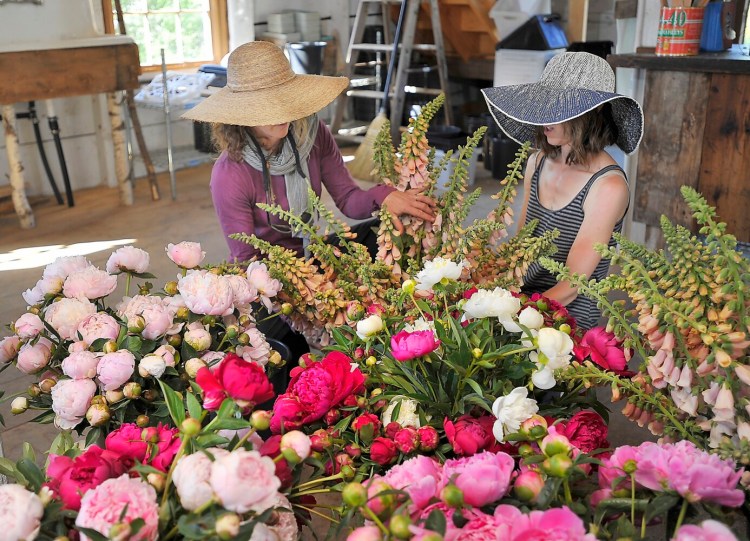Commercial flower arrangements are typically made from annuals, but in a recent online program, Scarborough flower farmer John Bliss discussed using perennial plants instead.
Bliss owns Broadturn Farm in Scarborough with his wife, Stacy Brenner. The farm sells flowers directly to customers and also uses them at weddings hosted on the farm grounds.
The advantage of using perennials for cut flowers is obvious: While perennial flowering plants may not last forever, they do last for a long time – and certainly longer than annuals’ one-year lifespan – saving gardeners time and effort.
A disadvantage is that perennials are in blossom only briefly each year, while annuals can produce flowers continually from early in the season until the first snow. But that’s an easy problem to solve: Grow many different perennials, and you are guaranteed to have something in bloom throughout the season.
“Our approach to flower design is inspired by nature, and sometimes it mimics nature,” Bliss told the online audience. “Textures are just as important as blooms. Each component has a story to tell.”
Mainers will likely be familiar from their own gardens with the perennials and woodies that Bliss and Brenner grow commercially for flower arrangements. Among the woodies they feature are hydrangeas, viburnums, hollies, spirea, clematis, roses, smokebush, several varieties of physocarpus (ninebark), willows for both the catkins and the stems, fruit trees for both blossoms and fruit, and thornless raspberries. Excepting the berries, my wife, Nancy, and I grow all of those on our property, too, which is much smaller than Broadturn Farm. And we do grow regular raspberries for the fruit.
Bliss and Brenner’s list of herbaceous perennials is also long, and also offers many plants homeowners typically grow in their yards: Alliums, herbs, daffodils, columbine, fritillaria, phlox, echinacea and the like. Admittedly, most homeowners don’t have the full half acre of peonies that Broadturn grows. To get them through the lean times, when not much is in bloom, Broadturn grows a lot of grasses, including miscanthus, and plants like fantail willow and echinops (globe thistle).
But if the selection is similar to that of a home garden, Broadturn’s flower-growing methods are not. Unlike most home gardeners, Broadturn digs up and moves its perennials every three years, both to get rid of the weeds and give the plants some extra nurturing. They treat lady’s mantle, monarda (bee balm) and agastache (hyssop) — all perennials — as annuals. The woodies are planted in rows 12 feet apart. In the first few years that Bliss and Brenner ran the flower farm, they grew herbaceous perennials between those rows. But after a few years, the trees and shrubs filled in the space.
The Broadturn crew adds more organic matter than normal, almost double what is recommended for home gardeners, and more fertilizer, as well. To prevent weeds, the gardens are heavily mulched. Watering heavily is likewise essential, Bliss said. He prefers micro-sprinklers to drip irrigation because they water more evenly. With drip lines, plant roots tend to grow toward the area closest to the lines.
Celeste Parke, Broadturn’s chief flower designer, told the audience that she tries to let nature be her guide for her floral designs. In early spring, for instance, she incorporates dried seed pods and branches that have been outside through the winter. She uses a lot of physocarpus because it comes in many different colors and changes slowly throughout the seasons. Mountain mint is another essential plant for her, with its blossoms and, depending on the variety, thin or broad foliage. Parke uses the round, blue-green leaves of baptisia as a substitute for eucalyptus, a popular plant for flower arrangements that must travel many miles to get to your arrangement: It comes from Australia and New Zealand.
Parke tries to avoid floral foam, which doesn’t decompose. Instead, she uses big heads of sedum or hydrangea flowers, putting the stems of other blossoms in her arrangement through them to hold the blossoms securely in place.
Both Bliss and Parke mentioned using invasive plants, such as bittersweet and autumn olive, in their arrangements. Bliss and Brenner didn’t plant these species at Broadturn Farm; they were already growing there when the couple bought the property. Before using the bittersweet and autumn olive, they remove all the fruits and seeds to ensure that their flower arrangements don’t inadvertently spread the invasive species. Broadturn Farm has a hot compost heap, and Bliss said he has never seen bittersweet sprout from his own compost. Although using invasive plants in that manner is probably safe, I wouldn’t do it. It might encourage others who aren’t as careful.
Tom Atwell is a freelance writer gardening in Cape Elizabeth. He can be contacted at: tomatwell@me.com
Send questions/comments to the editors.




Comments are no longer available on this story